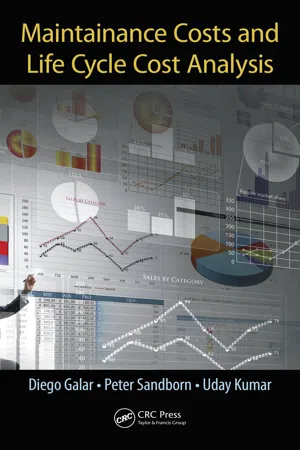
- 492 pages
- English
- ePUB (mobile friendly)
- Available on iOS & Android
Maintenance Costs and Life Cycle Cost Analysis
About This Book
Authors have attempted to create coherent chapters and sections on how the fundamentals of maintenance cost should be organized, to present them in a logical and sequential order. Necessarily, the text starts with importance of maintenance function in the organization and moves to life cycle cost (LCC) considerations followed by the budgeting constraints. In the process, they have intentionally postponed the discussion about intangible costs and downtime costs later on in the book mainly due to the controversial part of it when arguing with managers.
The book will be concluding with a short description of a number of sectors where maintenance cost is of critical importance. The goal is to train the readers for a deeper study and understanding of these elements for decision making in maintenance, more specifically in the context of asset management. This book is intended for managers, engineers, researchers, and practitioners, directly or indirectly involved in the area of maintenance. The book is focused to contribute towards better understanding of maintenance cost and use of this knowledge to improve the maintenance process.
Key Features:
• Emphasis on maintenance cost and life cycle cost especially under uncertainty.
• Systematic approach of how cost models can be applied and used in the maintenance field.
• Compiles and reviews existing maintenance cost models.
• Consequential and direct costs considered.
• Comparison of maintenance costs in different sectors, infrastructure, manufacturing, transport.
Frequently asked questions
Information
1
Relevance of Maintenance Function in Asset Management
1.1Purpose of Maintenance Function
- To maintain
- Keep in existing condition
- Preserve, protect
- Keep from failure or decline
A specific duration of failure-free performance under stated conditions.
1.1.1Maintenance Function
- Retaining an asset in a specified condition
- Restoring an asset to a specified condition

An illustration of factors influencing maintenance objectives.
Table of contents
- Cover
- Halftitle Page
- Title Page
- Copyright Page
- Contents
- Preface
- Acknowledgments
- Authors
- 1. Relevance of Maintenance Function in Asset Management
- 2. Maintenance Costing in Traditional LCC Analysis
- 3. Maintenance Budget versus Global Maintenance Cost
- 4. Maintenance Performance Measurement: Efficiency
- 5. Consequential Maintenance Cost: A Problem Area
- 6. Maintenance Services and New Business Models: A New Way to Consider Costs
- 7. Maintenance Costs Across Sectors
- Index